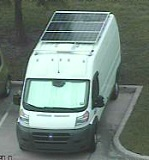They may not want their configuration stored in $HOME, for example:
they’re on a machine that isn’t under their physical control and ~/.config is mounted over the network from their personal machine;
That sounds like it’s a bad way to handle configuration, since among many other problems, it won’t work with the many programs that do have dotfiles in home directory, but even if that happened, you could just symlink it.
they prefer to version control their configuration files using git, with a configuration directory managed over different branches;
I do that. I symlink that config into a git-controlled directory. If OP plans to put his entire ~/.config in git, he is doing things wrong, because some of that needs to be machine-local.
the user simply wants to have a clean and consistent $HOME directory and filesystem
If whatever program you are using to view your home directory cannot hide those files, it is broken, as it does not work with a whole lot of existing software.
less secure,
If your home directory is “not secure”, you’re probably in trouble already.
Like, there are reasons you may not want to put dotfiles in a homedir, but none of the arguments in the article are them.
EDIT: I will ask developers to stop dumping directories and files that don’t start with a dot in people’s home directories, though. I gave up over twenty years ago and put my actual stuff under ~/m just to keep it from being polluted with all the other things that dump non-dotfiles/-dotdirs in a home directory. Looking at my current system, I have:
-
A number of directories containing video game saves and configuration. I am pretty sure that these are mostly bad Windows ports or possibly Windows programs under WINE that just dump stuff into a user’s home directory there (not even good on Windows). Some are Windows Steam games.
-
WINE apparently has decided that it’s a good idea to default to sticking the Windows home directory and all of its directories in there.
-
Apparently some webcam software that I used at one point.
-
A few logfiles
I agree with most of your points. Just wanted to add that I use Git + GNU Stow to manage this exact situation and it works flawlessly.
I just keep all my actual stuff in a separate /stuff partition, so my home folder is only config files. Then I use NixOS home-manager and Impermanence to manage the dotfiles.
Yeah, I think I tried it and it didn’t do something I wanted and so used a homebrew script for the same thing, but it or a similar package or script is definitely what I’d recommend.
That should work with dotfiles in .config, in the home directory, any other config you want to be portable across machines, etc.
I agree with most of your points, but I still think putting configs in the xdg dir instead of putting tons of dotfiles in $HOME is good practice.
I find dotfiles to be that stuff that I want to edit easily, and xdg stuff to be that stuff that I don’t edit frequently (manually at least)
Somehow I’ve never considered using git for version controlling/version synchronizing anything other than exclusively code… Brb gonna git all my files.
-
Cough Snap cough
And wtf is with anaconda3 just permanently changing your “user@machine” terminal prompt?? Who thought that was a good idea?
As someone who uses anaconda, it’s quite useful to know what environment I’m in, but I definitely don’t have it enabled by default.
I absolutely despise the following directories: Documents, Music, Pictures, Public, Templates, Videos. Why? Because applications randomly dump stuff into these directories and fill them with junk files. I don’t want any application putting anything into directories I actually use, unless I explicitly tell them to. It is not possible to keep your files organized if applications randomly dump trash files into them.
I absolutely despise the following directories: Documents, Music, Pictures, Public, Templates, Videos.
Change them: https://wiki.archlinux.org/title/XDG_user_directories
Same shit happens on Windows. Games will just install their shit literally all over OS with no rhyme or reason to it.
Why can’t the save game and config.ini just be in the main god damn game directory? Nobody knows.
Microsoft OWNS not just gaming companies, but one of the largest gaming hardware companies and many of the largest game developers.
You’d think by now we’d get a dedicated Saves folder to organize this shit after this long.
My Documents > My Games is kinda the default, but then you have steam cloud syncing and tons of games that default to various Appdata folder seemingly at random.
There is, been there since 7. Just hardly any game Devs use it, including Microsoft.
C:\Users\Username\Saved Gamesis a thing. Not a lot of games use it though.There’s also
C:\Users\Username\Documents\My Gameswhich seems more popular with some devs. Though some devs inexplicably use the base Documents folder, which is just obnoxious.But yeah, a lot of devs still use AppData. I read a post from a dev once that explained the advantages and disadvantages to each Directory, though I can’t remember the specifics, there is at least logic to why saves get stored in so many odd locations.
hough some devs inexplicably use the base Documents folder
Shoutout to Anno 1404 which creates no less than 4 directories in the base Documents directory each for slightly different releases for the game that they later rolled into a single release so your user data is strewn across all of them if you bought the most complete release of the game
deleted by creator
Why can’t the save game and config.ini just be in the main god damn game directory?
You’d lose all save games every time you uninstall the game. We already had that in DOS/Win9x days and I am very happy that we moved away from this. Static program data and generated data should be clearly separated.
In Linux we have the XDG Base Directory spec for that, that gives you directories for cache, config, state and data, so everything is nicely separated. The only problem is that not every app follows it, bug reports can help.
I find Android handles this by far the worst. They have the core right idea with permissions that makes it impossible for games to write outside of their assigned directories, but the way they handle it your savegames go into an area that will be deleted when you uninstall the app. So the risk of losing savegames is extremely high. The alternative is that games require SD card permissions and than just write wherever they want. It’s basically all just a dark pattern to force games into using the Google Play service for cloud saves. Games that lose state and restart when you switch apps are also great.
I mean, in Windows they literally have a “saved games” folder and almost no games use it. I too hate that most fucking games have to save their shit to the Documents directory. That’s the directory FOR MY FUCKING DOCUMENTS, NOT GAME SAVEDATA
I have my own directories on windows. I never use system provided directories for my own stuff, it always sucks. And if I want to move directories between drives or just change permissions, all hell breaks loose because everything depends on the default locations… So I just leave them be if I can.
Actual reason is system permissions.
Most the default installation path is Program Files. That needs elevation to write to. Fine when you’re installing something, but not something you want to need just to run the game.
Writing to %APPDATA% or really anywhere in %USERHOME% is guaranteed to have the right permissions for this user.
Granted, a lot of home PCs and gaming PCs are single-user environments. The “personal” computer. In that case there’s no reason games and applications can’t be installed in %LOCALAPPADATA%, and in fact, I think windows has an environment variable or registry setting for that.
It’s no different in Linux. You don’t want users writing to /etc. And you may expect multiple users. So all of that stuff goes to dot files in $HOME.
Granted, a lot of home PCs and gaming PCs are single-user environments. The “personal” computer. In that case there’s no reason games and applications can’t be installed in %LOCALAPPADATA%, and in fact, I think windows has an environment variable or registry setting for that.
I tried setting up my main windows gaming machine with a separate admin and user accounts, and tried to set it up to be multi-user. It didn’t work well. Most games worked but some random games had all sorts of bizarre issues, from only being able to run as admin, to requiring messing with directory permissions to just plain strange behavior but working sometimes. Steam also really didn’t like if I tried to run games as a different user and got very confused at times by the multiple user accounts
See, that’s dumb. Just because games aren’t enterprise software, there’s no reason basic security practice like least-privilege shouldn’t apply in development.
Hence dot files
They’re probably trying to handle per user config. But nowadays, there’s mostly only one user using a machine.
These places are a cesspool of junk in every system, it’s incredible. MacOS has this kind of shit too, just like Windows, with apps dumping crap there without a care.
I just keep my stuff far away from
$HOMEand not bother about the junk. Not even a subdirectory under$HOME.Same goes for ’ My documents’ on windows.
This is why I’ve made a “Filing Cabinet” directory. My stuff goes in there nice and organized, while I ignore the rest.
Is there any good gui application for mange these but also edit them in a user friendly way like getting a dropdown for a settings like: Yes/No, Country Sweden. Number size range etc. So include validation. Even nix os does not have that.
deleted by creator
Duly noted.
Even when using home manager or any other dotfile manager your $HOME folder is still filled with junk. It maybe in your controlled repo but it still ends up as symlink to that repo.
Here is nice help for python software to determine XDG directories (and more): https://pyxdg.readthedocs.io/en/latest/basedirectory.html
PyXDG contains implementations of freedesktop.org standards in python.
I’d like to set nautilus to show hidden files, but I can’t stand the amount of “trash” there’s in home
Everyone is thinking “my app is the best, it totally deserves a ~/.myappisthebest directory”
Yes please!
My $HOME is my castle (・へ・)
@Blizzard @American_Jesus lol love that
Nix and Home Manager have been my go-to for managing dotfiles and symlinks in my home dir
Is there an easy way to learn this for just the package manager? Most of the tutorials I find are tailored to NixOS, which I’m not using and don’t plan on using.
For what it’s worth, I don’t understand the nix language or all the package manager functions in their entirety. I generally use what I need and that’s it. Most information I’ve required that is
nixpkgs-specific I was able to find in the manual. home-manager has one as well and it’s been the best reference for me.You can absolutely use nix and home-manager without NixOS, you can even use it on a Mac!
Most of the tutorials I find are tailored to NixOS
I think that’s less true than you think. There’s definitely a lot of tutorials from people who do use NixOS… But this mostly doesn’t matter, using nix is more or less the same regardless of operating system. There is some stuff specific to NixOS, but that’s mostly just using nix to configure system services.
Is there an easy way to learn this for just the package manager?
That said… There’s not a super easy gateway to learning nix, unfortunately. The easiest way to learn is probably to try to package one of your personal projects, or by learning home-manager and trying to fully declare your home environment. Packaging programs in certain languages can involve having to learn more about the nix ecosystem than others (e.g., python is a little more complicated than what you’d need to package a simple C program, because python has it’s own ecosystem that you have to integrate with).
Probably the best introduction is the nix pills if you want to learn how nix works (not necessarily how to use it, but it will give you a really solid foundation):
https://nixos.org/guides/nix-pills/
Though, it’s really common for people to bounce off of the nix pills because they start kind of slow. If you can follow through them, though, you’ll have a good understanding of the nix language and how it’s used to construct derivations for building packages.
The nix language is much maligned, but it’s actually not as bad as you think going in (error messages can be ATROCIOUS, however). It looks a bit weird, but I think if you go in with the understanding that it’s “Turing Complete JSON” you’ll have a better time. Almost everything you’re doing in nix is building up attribute sets (which are basically just JSON dictionaries) which specify the dependencies and build stages of a project… But it’s not a static representation like JSON, you can call functions to do arbitrary computations to build up fields (e.g., I have some functions to automatically set up wireguard configurations from a description of the network layout of my machines, so it’s useful to be able to do this stuff).
If a program just uses
$HOMEor someone starts writing a new application, how is that supposed to help?I’m not sure I understand. So you create a symlink from
$HOME/.program.inito something in the nix store? If so, how does that solve the problem of clutter in$HOME?You’re right, it doesn’t. That does give me an idea though.
You could use overlayfs with an opaque upper directory to hide the files littering your $HOME and still access them by bind-mounting them into the appropriate xdg dirs.
Way more effort than it’s worth, of course.
If so, how does that solve the problem of clutter in $HOME ?
If it wasn’t clear from my message, the problem(s) these tools are solving for me would be 1. not having to keep track of my dotfiles and their directories, and 2. not storing configuration files directly on the disk I use for the
$HOMEdir. I’m not claiming these tools would solve clutter in the$HOMEdir. Further, I think it should be alright for me to share tools for managing configuration files in your home directory in a discussion that directly relates to that subject.So you create a symlink from $HOME/.program.ini to something in the nix store?
Normally it’s the other way around. When you use nix and home-manager, you’re technically generating files that will live in the nix-store and nix/home-manager will take care of symlinking those files to locations in your
$HOMEdir.In this scenario though, I would use the https://nix-community.github.io/home-manager/options.html#opt-home.file option from home-manager to create a symlinks to a location that’s outside of my
$HOMEdir so those files don’t have to live on my home disk.My particular use-case is that I want persistent configuration files that are shared throughout a handful of devices on my network. To this end, I use some home-manager symlinks that lead to a network folder where all these various directories and configuration files actually live. I edit those configurations in a single place and their changes propagate across the network to all the devices that would use them.
Also if the normal invocation of your program produces more than 3k lines of stdout, sanitize it and default to a file.
It needed to be said.
You might wanna backup your dotfiles somewhere remote too. I literally lost dotfiles that I’d been building up for years because I couldn’t remember the password to my Linux machine after coming back from vacation. Funny enough though, a couple hours after nuking my OS I magically remember my password.
After two years of typing in the same boot pass on my same laptop at my same job I woke up one day and couldn’t remember it. Almost died trying. Right as I was reaching out to my admin it came to me.
Put your dotfiles in git (or source control of your choice)- massages it easier to propagate improvements across machines!
Oof. Yeah, I once forgot my LastPass password literally less than 30 seconds after entering it on another device. Muscle memory versus active memory kind of thing.
Unless you disk was encrypted, you could have booted up a live distro and back up the files you needed (or even overwrite the shadow file to get a new password)
And maybe could still get them with testdisk 😁
I really did try so many forensic and recovery tools after remembering my password but with no luck 😂
I’m glad you tried! Stories of needless data loss really get to me 😹
In the late 90s I taught an intro course for folks who wanted to run *nix boxen (Solaris, IIRC). On the afternoon of the last day I had them swap places after lunch and gain root access to each others’ machines. It was partly for root passwd recovery and other maintenance tasks, but also to demonstrate that physical access to the box was a serious issue.

















